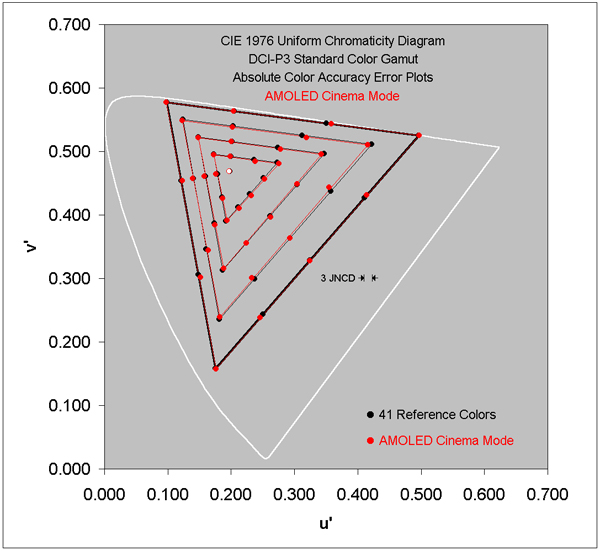 Ray Soneira of DisplayMate got early access to the Samsung Galaxy S9 smartphone to run his comprehensive tests on the display and pronounced it “the best performing smartphone display ever’ and the first to get a new A+ grade. For the full, breathless, verbiage, you can head over to the DisplayMate site. Like its predecessors, the S9 uses a Diamond subpixel arrangement for sub-pixel rendering.
Ray Soneira of DisplayMate got early access to the Samsung Galaxy S9 smartphone to run his comprehensive tests on the display and pronounced it “the best performing smartphone display ever’ and the first to get a new A+ grade. For the full, breathless, verbiage, you can head over to the DisplayMate site. Like its predecessors, the S9 uses a Diamond subpixel arrangement for sub-pixel rendering.
Although, on the face of it (pun intended) the S9 looks almost the same as the S8, there are many improvements in the display performance. Once again, DisplayMate said that display accuracy hit a new record of 0.7JNCD (just noticeable colour differences), which is ‘visually indistinguishable from perfect’, although, if this is the case, it seems slightly perverse to keep track of records!
As before, accuracy is very good, regardless of the colour space used, whether DCI-P3, AdobeRGB or sRGB/Rec.709. The phone reaches 101% of DCI-P3 in that mode because of the use of a new deep red OLED matierial. The phone covers 98% of AdobeRGB when configured for that gamut. In peak mode, the widest gamut is 114% of P3. The gamut coverage falls away in high ambient, of course, but still achieves 53% at 2,000 Lux.

One of the features that helps in high ambient is good anti-reflective performance and the S9 has 4.4% screen reflectance, the lowest seen by DisplayMate so far on a smartphone and contrast even in high ambient is 83:1 to 124:1, another record. Like the S8, the S9 has ambient light sensors on both sides of the phone and the phone has an improved setting mode to adjust its use for individual users.
The enhanced bright mode is 20% brighter than the S8, and that is a significant difference as performance in high ambient is dependent on this factor, among others. The viewing angle performance is also improved (although it was already very good) and there a number of new modes with particular improvements in the way that the OLED maintains more constant brightness, regardless of the average picture level (APL) of the content. (OLEDs have high peak brightness, but high APLs reduce the peak because of power limits). Soneira measures the variation as just 6% in the calibrated mode, although this increases to 39% in the High Brightness mode of 1,130 cd/m².
The phone supports HDR and is certified by the UHD Alliance as meeting the Mobile HDR Premium requirements. The phone also has a number of settings for improved vision accessibility, including a colour lens mode and a colour adjustment mode for those with visual impairments. There are new Night Modes with reduced blue light and a ‘super dimming mode that takes brightness down to 2cd/m² for night mode. The always-on mode also adjusts to very low brighness if the phone is used as a clock overnight.
However, the new display does not improve the power efficiency compared to the S8. Other display features include correct operation in landscape and portrait mode, even when used with polarising sunglasses and Gorilla Glass 5 for protection.
Analyst Comment
Ray is an acknowledged expert on display measurement (I recently referred a potential consulting job to him), but I have to take issue with him on one point in his review. In his article he says
“Some clueless reviewers have been pining for 4K 3840×2160 Smartphones, which would require almost double the pixels, memory, and processing power of the 2960×1440 display on the Galaxy S9, but there would be no visual benefit for humans! As a result, it is absolutely pointless to further increase the display resolution and pixels per inch (ppi) for a marketing wild goose chase into the stratosphere, with no visual benefit for humans!”
That is poor from someone who is very proud to be considered a “internationally recognized research scientist with a distinguished career that spans physics, computer science, and television system design” (DisplayMate website). However, to label other scientists, that may, just, know more than him in the area of human factors as ‘clueless’ is offensive. Candice Brown-Elliot has written for Display Daily on the subject in the past and was the inventor of the Pentile Matrix technology used by Samsung in this OLED. (The Display Resolution War – How much resolution is enough? (Part 2)) and she has explained why 1200ppi is probably the end point – and you call Candice ‘clueless’ at your own peril!
Further (and I have raised this with Ray several times, in person in the past), he always refers back to “20/20 vision”. 20/20 vision is not perfection, it is just the average, with black text on a white background in eye tests. Human perception is much more complex that eye tests. In just looking at CPD and eye charts, he ignores the work by NHK that went into the decision to push for 8K. If you do the maths based on 20/20 or even 20/10, which pilots and youngster have, then there is some merit to what he says, but with ‘real world images’, NHK saw feedback from viewers on ‘more realistic images’ right up to double the resolution of 20/10 (and at that point, they stopped testing).
In addition, I have previously raised the issue of the use of phones in VR headsets, where the extra resolution is a real advantage in reducing the pixellation, but Ray told me that he doesn’t think that the application is significant and important. It may not be, to him, but there will be users that want to use the latest phones for VR and they would appreciate the extra resolution. (BR)

